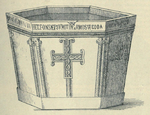Marija Bistrica
Marija Bistrica | |
|---|---|
Municipality | |
 View of Marija Bistrica | |
| Coordinates: 46°0′19″N 16°07′07″E / 46.00528°N 16.11861°E | |
| Country | Croatia |
| County | Krapina-Zagorje County |
| Government | |
| • Municipal Mayor | Josip Milički |
| Area | |
• Municipality | 68.6 km2 (26.5 sq mi) |
| • Urban | 4.0 km2 (1.5 sq mi) |
| Elevation | 192 m (630 ft) |
| Population (2021)[2] | |
• Municipality | 5,553 |
| • Density | 81/km2 (210/sq mi) |
| • Urban | 1,045 |
| • Urban density | 260/km2 (680/sq mi) |
| Time zone | UTC+1 (CET) |
| • Summer (DST) | UTC+2 (CEST) |
| Postal code | 49 246 |
| Area code | 049 |
| Website | marija-bistrica |
| Part of a series on the |
| Catholic Church in Croatia |
|---|
 |
Marija Bistrica (Croatian pronunciation: [mǎrija bîstrit͡sa]) is a village and municipality in the Krapina-Zagorje County in central Croatia, located on the slopes of the Medvednica mountain in the Hrvatsko Zagorje region north of the capital Zagreb. The municipality has 5,976 inhabitants, with 1,071 residents in the settlement itself (2011 census).[3]
Marija Bistrica has an old Marian shrine of the Black Madonna which is a place of pilgrimage and visited by hundreds of thousands of pilgrims every year. On 3 October 1998, Pope John Paul II visited Marija Bistrica and beatified Croatian Cardinal Aloysius Stepinac in front of a crowd of 500,000 Croatians.[4]
History
[edit]The first written mention of the settlement Bistrica dates back to 1209 AD, as the possession of Croatian-Hungarian king Andrew II. Documents from 1334 first mention the church of Saints Peter and Paul.
Shrine
[edit]
In 1545 a local priest hid the wonder working statue of the Blessed Virgin Mary with the Infant Jesus, which previously stood in a wooden chapel on the Vinski Vrh (Hill) nearby, within the church to save it from the Turks and took the secret of its hiding place to his grave. The statue was discovered in 1588, when according to the records bright light shone from the place where it was buried. In 1650 the statue had to be once again hidden to be rediscovered in 1684.
In 1710 the Croatian parliament vowed to fund a new altar in the church, which was done in 1715. In 1731 the church was expanded and reconsecrated to Our Lady of the Snows. In 1750 Pope Benedict XIV granted plenary indulgence to pilgrims who confess and accept the Eucharist in Bistrica. From 1879 to 1882 a new church was built in its place, designed in the style of Neo-Renaissance by Hermann Bollé. Arcades were constructed around the church decorated with 22 paintings of the miracles granted by the Blessed Virgin. During the construction a fire destroyed all of the church except the statue and the main altar. In 1923 Pope Pius XI granted the church the status of a minor basilica and in 1935 the archbishop of Zagreb Ante Bauer crowned the statue as Our Lady Queen of Croatia. As archbishop, Aloysius Stepinac paid special attention to the site and made annual pilgrimages. On 8 July 1945 he led his last pilgrimage to Marija Bistrica which drew 40,000-50,000 people.[5]
Municipality
[edit]The municipality consists of the following settlements:[3]
- Globočec, population 525
- Hum Bistrički, pop. 441
- Laz Bistrički, pop. 788
- Laz Stubički, pop. 267
- Marija Bistrica, pop. 1,071
- Podgorje Bistričko, pop. 904
- Podgrađe, pop. 321
- Poljanica Bistrička, pop. 347
- Selnica, pop. 653
- Sušobreg Bistrički, pop. 81
- Tugonica, pop. 578
Gallery
[edit]-
Main square in Marija Bistrica
-
The basilica
-
Interior of the basilica
-
Arcades surround the basilica
-
Arcades surround the basilica
-
Outside view of the basilica
-
Open air church near the basilica
-
12th Station of The Way of the Cross at Marija Bistrica open air church
-
Altar of the Marija Bistrica basilica
References
[edit]- ^ Register of spatial units of the State Geodetic Administration of the Republic of Croatia. Wikidata Q119585703.
- ^ "Population by Age and Sex, by Settlements" (xlsx). Census of Population, Households and Dwellings in 2021. Zagreb: Croatian Bureau of Statistics. 2022.
- ^ a b "Population by Age and Sex, by Settlements, 2011 Census: Marija Bistrica". Census of Population, Households and Dwellings 2011. Zagreb: Croatian Bureau of Statistics. December 2012.
- ^ Bunson, Matthew and Margaret (1999). John Paul II's book of saints. Our Sunday Visitor Publishing. pp. 90–92. ISBN 9780879739348. Retrieved 28 February 2011.
- ^ Akmadža, Miroslav. Causes of breaking of diplomatic ties between the Vatican and Yugoslavia in 1952
External links
[edit]- Official website
- Website of the Shrine (in English, Croatian, and German)
- Short info











